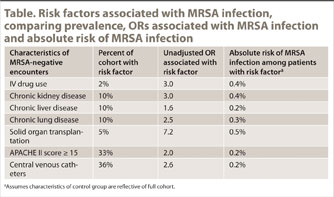Less is more: The uncommon need for vancomycin
Antibiotic overuse in the United States has been notable, with prescribing rates far exceeding other developed nations. Prescribing of unnecessary or inappropriate antibiotics in the ICU is estimated to be 30% to 60%.
In a recent study, Chotiprasitsakul and colleagues showed the extensive use of ultimately unnecessary vancomycin in ICU patients at a renowned institution. Although not all empiric vancomycin use is unsubstantiated, vancomycin is commonly overprescribed because of a fear of MRSA infection that far exceeds the actual epidemiologic risk. Chotiprasitsakul and colleagues highlighted this dissociation by demonstrating that empiric vancomycin was prescribed for 36% of patients despite the fact that the overall risk for MRSA-positive clinical cultures in their cohort (patients with a nasal swab who did not have a history of MRSA) was only 1.2% (148/11,882), and the risk for clinically defined MRSA infection was 0.8% (90/11,882).

This undue fear of MRSA infection is inadvertently strengthened by medical training and published literature that focus on defining risk factors in the form of odds ratios without providing the essential context of absolute risk. The dissociation between ORs and actual risk was again highlighted by Chotiprasitsakul and colleagues and noted in the Table, which demonstrates the disconnect between the high prevalence of risk factors, their high ORs associated with MRSA infection and yet a very low risk for actual MRSA infection (< 1%). This is because a multifold increase in a miniscule risk is still a miniscule risk, even in ICUs at a quaternary care medical center.
Although guidelines explicitly state that local epidemiology and resistance patterns should be used to tailor recommendations for empiric therapy for local use, this is difficult to translate into actual practice for several reasons. First, it is easier to learn and teach about the ORs of risk factors than it is to obtain local data and understand local risk. Second, physicians appreciate recommendations that are certain and resolute, and local risks can change and lead to recommendations requiring updating. For example, the admission prevalence of MRSA among ICU patients at Johns Hopkins is much lower (3%) than is reported in the literature. In addition, the hospital-onset proportion of MRSA infection risk in their ICUs has most certainly declined over the years to its current near-zero level with high-compliance hand hygiene, active screening leading to rapid contact precautions, and the introduction of daily chlorhexidine bathing. Third, the application of local data into local policies and practices requires a robust investment in antibiotic stewardship programs, which are still in their relative infancy in most places. Nevertheless, the great impact that local risk can and should have on empiric therapy emphasizes the critical value of effective antibiotic stewardship programs to monitor, modify and enforce local recommendations for empiric and pathogen-directed antibiotic therapy.
In the setting of local data demonstrating a low prevalence of MRSA and a very low rate of MRSA infection in the ICU, it is perhaps not surprising that a negative MRSA nares culture has such a high negative predictive value (both among all ICU patients with a negative test, as well as among those treated with empiric vancomycin). However, given its notable positive and negative predictive values of 32%, the swab provides physicians with a highly discriminatory test that can and should drive empiric prescribing behavior when infection is suspected. MRSA carriage appears to be the solo risk factor that has such a high discriminatory value when the rate of MRSA infection is very low despite the sizable presence of other well-described risk factors. If used to guide empiric therapy, Chotiprasitsakul and colleagues found that it could prevent 600 days of unnecessary vancomycin use per ICU per year.
In summary, Chotiprasitsakul and colleagues provide an important window into several aspects of antibiotic stewardship. This important manuscript reminds us of 1) the need for physicians and antibiotic stewardship programs to act upon absolute risk, not just risk factors, when establishing protocols and prescribing empiric antibiotics at each and every hospital; 2) the importance of a robust antibiotic stewardship program to assess and address local risk as an imperative to empowering clinicians with the best available data to drive appropriate prescribing; and 3) the value that knowledge of MRSA carriage provides, based upon a nasal swab, as a potent predictor and discriminator for empiric vancomycin, even in a critically ill patient population.
- References:
- Bergmans DC, et al. J Antimicrob Chemother. 1997;39:527-535.
- The Center for Disease Dynamics, Economics & Policy. Antibiotic prescribing rates by country. https://www.cddep.org/tool/antibiotic_prescribing_rates_country. Accessed March 19, 2018.
- Chotiprasitsakul D, et al. Infect Control Hosp Epidemiol. 2018;doi:10.1017/ice.2017.308.
- Huang SS, et al. J Infect Dis. 2007;doi:10.1086/510622.
- Kollef MH. Crit Care. 2001;doi:10.1186/cc1022.
- Lin MY, et al. Clin Infect Dis. 2017;doi:10.1093/cid/cix1056.
- Mandell LA, et al. Clin Infect Dis. 2007;doi:10.1086/511159.
- For more information:
- Susan S. Huang, MD, MPH, is a professor of medicine in the division of infectious diseases and the Health Policy Research Institute at the University of California, Irvine School of Medicine, and the medical director of epidemiology and infection prevention at UC Irvine Health.
Disclosure: Huang conducts clinical trials and studies in which participating hospitals and nursing homes receive contributed antiseptic products from Sage Products/Stryker, Molnlycke, 3M, Clorox, Xttrium and Medline.

